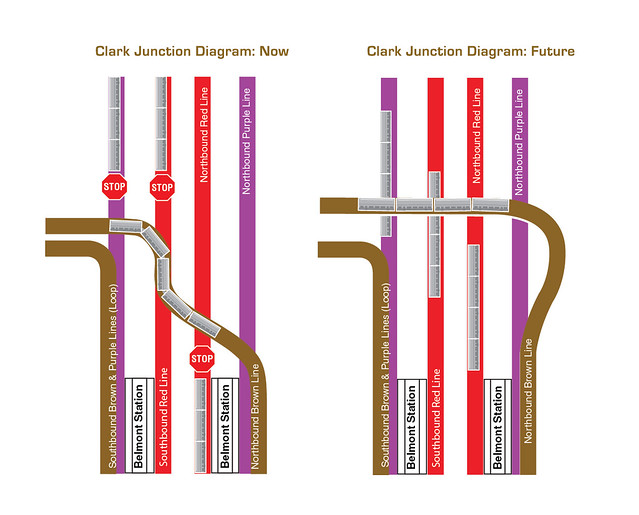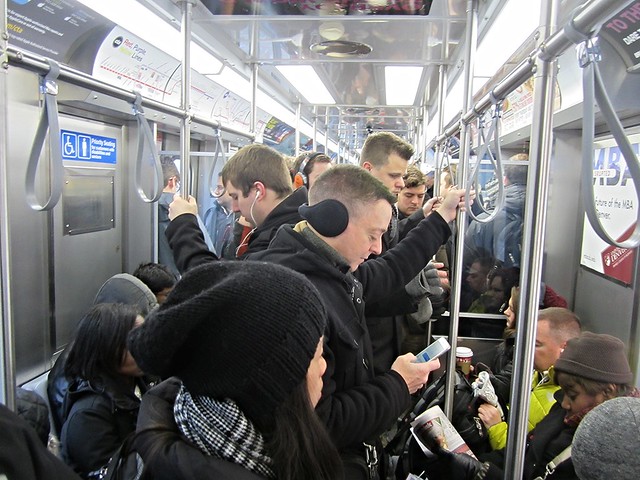[The Chicago Reader recently launched a weekly transportation column written by Streetsblog Chicago editor John Greenfield. This partnership allows Streetsblog to extend the reach of our livable streets advocacy. We syndicate a portion of the column after it comes out online; you can read the remainder on the Reader’s website or in print. The paper hits the streets on Thursdays.]
When I recently rode the Red Line downtown during the morning rush, my rail car was as packed as a sardine can by the time we left the Belmont stop. Damon Lockett, a copywriter who commutes daily from Edgewater to River North, told me that overcrowded trains are typical during peak hours nowadays.
"They don't run enough trains," said Lockett, who moved here from New York City about a year ago. "You're waiting ten or 15 minutes for a train, while the platform's just loading up with people."
The CTA is planning to address overcrowding on north-side el lines with the upcoming Red-Purple Modernization project. This multibillion-dollar initiative will completely overhaul the nearly 100-year-old Red Line from Belmont to Howard and the Purple Line from Belmont to Linden, in suburban Wilmette.
The agency says the project's single most important time-saving and capacity-building element is the Red-Purple Bypass, better known as the Belmont flyover. This $570 million proposal would unsnarl the junction north of Belmont—where Brown Line trains cross Red and Purple Line tracks—by building a roller-coaster-like overpass.'
The flyover, and the rest of the modernization plan, recently got the federal go-ahead after passing an environmental review by the Federal Transit Administration. Construction could start as early as late 2017. But hurdles to the project remain: the CTA still needs to find $1.9 billion in funding for the first phase of plan, and many central Lakeview residents are bitterly opposed to the flyover, which would require the demolition of 16 buildings.
Local transit experts and advocates argue that the flyover is essential for meeting future demand. Ridership along the Red Line corridor north of Belmont grew by 40 percent between 2010 and 2014, according to CTA spokeswoman Tammy Chase.

The CTA estimates that, by unclogging the so-called Clark Junction, the bypass will allow the agency to add up to eight more Red Line trains, carrying 30 percent (7,200) more riders per hour during rush periods.
"While we can live without the flyover today, it's more to deal with the future," says DePaul University transportation expert Joseph Schwieterman. "The project is for the 25 percent growth in the corridor that's projected over the next 20 years—and that's a conservative projection."
The additional capacity made possible by the flyover would result in 43,200 additional daily trips, or more than ten million additional trips annually, according to calculations made by UIC's Urban Transportation Center.
In addition to increasing rush-hour capacity, Chase says, the flyover would eliminate the crossing delays that affect at least 40 percent of Red, Purple, and Brown Line trains.
"The conflict at the junction and the speed-restricted curve combine to slow each train traveling between Belmont and Addison by one to three minutes on average," she says.
Mayor Emanuel appears to have exaggerated the flyover's benefits when he announced the flyover project in April 2014.
"We're going to increase the capacity by 30 to 50 percent of moving trains on time rather than the three- to four-minute wait," he said at the press conference.
Soon afterwards, the Reader's Ben Joravsky did a somewhat unscientific test of the Clark Junction delays, clocking more than 30 trains from the Belmont platform with a stopwatch. He found that the typical wait was only 25 to 30 seconds, and the longest delay was roughly 40 seconds.
But the CTA stands by the project’s necessity. “We’ve always talked about it being about the capacity as well as the congestion,” Chase says.




